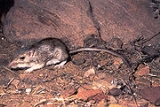
Chaetodipus
Encyclopedia
Chaetodipus is a genus of pocket mouse containing 19 species endemic to the United States
and Mexico
. Like other members of their family
such as pocket mice in the genus Perognathus
, they are more closely related to pocket gopher
s than to true mice
.
), most species of the genus Chaetodipus have harsh pelage with some bordering on spiny hair. They tend to be found in arid habitats where they feed on seeds, vegetation, and insects (Nowak, 1999). Females give birth to a litter of 2-9 young after a gestation period
of just under a month. The longest recorded life span
is 8 years and 4 months (Nowak, 1999).
Sometimes members of the genus Chaetodipus are placed in the genus Perognathus
.
United States
The United States of America is a federal constitutional republic comprising fifty states and a federal district...
and Mexico
Mexico
The United Mexican States , commonly known as Mexico , is a federal constitutional republic in North America. It is bordered on the north by the United States; on the south and west by the Pacific Ocean; on the southeast by Guatemala, Belize, and the Caribbean Sea; and on the east by the Gulf of...
. Like other members of their family
Heteromyidae
The family of rodents that include kangaroo rats, kangaroo mice and rock pocket mice is the Heteromyidae family. Most heteromyids live in complex burrows within the deserts and grasslands of western North America, though species within the Heteromys and Liomys genera are also found in forests and...
such as pocket mice in the genus Perognathus
Perognathus
Perognathus is a genus of pocket mouse. Like other members of their family they are more closely related to pocket gophers than to true mice.-Characteristics:...
, they are more closely related to pocket gopher
Pocket gopher
The pocket gophers are burrowing rodents of the family Geomyidae. These are the "true" gophers, though several ground squirrels of the family Sciuridae are often called gophers as well...
s than to true mice
Mouse
A mouse is a small mammal belonging to the order of rodents. The best known mouse species is the common house mouse . It is also a popular pet. In some places, certain kinds of field mice are also common. This rodent is eaten by large birds such as hawks and eagles...
.
Characteristics
Members of this genus range in size from 80-125 mm (head and body) and weigh 15-47 grams (Nowak, 1999). Unlike the silky pocket mice (genus PerognathusPerognathus
Perognathus is a genus of pocket mouse. Like other members of their family they are more closely related to pocket gophers than to true mice.-Characteristics:...
), most species of the genus Chaetodipus have harsh pelage with some bordering on spiny hair. They tend to be found in arid habitats where they feed on seeds, vegetation, and insects (Nowak, 1999). Females give birth to a litter of 2-9 young after a gestation period
Gestation period
For mammals the gestation period is the time in which a fetus develops, beginning with fertilization and ending at birth. The duration of this period varies between species.-Duration:...
of just under a month. The longest recorded life span
Maximum life span
Maximum life span is a measure of the maximum amount of time one or more members of a population has been observed to survive between birth and death.Most living species have at least one upper limit on the number of times cells can divide...
is 8 years and 4 months (Nowak, 1999).
Species
- Chaetodipus arenarius - Little Desert Pocket Mouse
- Chaetodipus artus - Narrow-skulled Pocket Mouse
- Chaetodipus baileyi - Bailey's Pocket Mouse
- Chaetodipus californicus - California Pocket Mouse
- Chaetodipus dalquesti - Dalquest's Pocket Mouse
- Chaetodipus eremicus - Chihuahuan Desert Pocket Mouse
- Chaetodipus fallax - San Diego Pocket Mouse
- Chaetodipus formosus - Long-tailed Pocket Mouse
- Chaetodipus goldmani - Goldman's Pocket Mouse
- Chaetodipus hispidus - Hispid Pocket Mouse
- Chaetodipus intermedius - Rock Pocket Mouse
- Chaetodipus lineatus - Lined Pocket Mouse
- Chaetodipus nelsoni - Nelson's Pocket Mouse
- Chaetodipus penicillatus - Desert Pocket Mouse
- Chaetodipus pernix - Sinaloan Pocket Mouse
- Chaetodipus rudinoris - Baja Pocket Mouse
- Chaetodipus spinatus - Spiny Pocket Mouse
Sometimes members of the genus Chaetodipus are placed in the genus Perognathus
Perognathus
Perognathus is a genus of pocket mouse. Like other members of their family they are more closely related to pocket gophers than to true mice.-Characteristics:...
.

